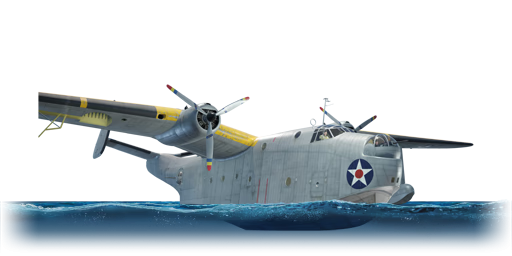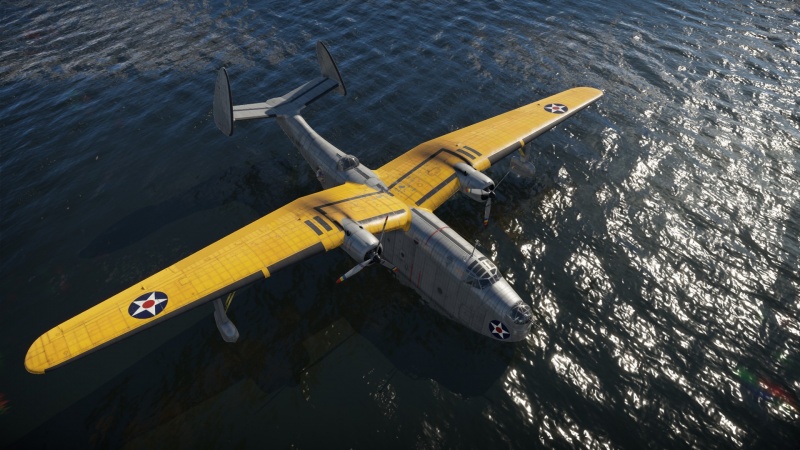Difference between revisions of "PBM-1 "Mariner""
Inceptor57 (talk | contribs) m |
m (Fixed typos) (Tag: Visual edit) |
||
| Line 76: | Line 76: | ||
{{Specs-Avia-Armour}} | {{Specs-Avia-Armour}} | ||
<!-- ''Examine the survivability of the aircraft. Note how vulnerable the structure is and how secure the pilot is, whether the fuel tanks are armoured, etc. Describe the armour, if there is any, and also mention the vulnerability of other critical aircraft systems.'' --> | <!-- ''Examine the survivability of the aircraft. Note how vulnerable the structure is and how secure the pilot is, whether the fuel tanks are armoured, etc. Describe the armour, if there is any, and also mention the vulnerability of other critical aircraft systems.'' --> | ||
| − | A robust aircraft and able to take more damage than others of size, compensating for lack of armor and slower speed. It also has .50 | + | A robust aircraft and able to take more damage than others of size, compensating for lack of armor and slower speed. It also has .50 caliber defensive machine guns covering nearly all angles, best angle is on beam where 3 of the mg's can converge. If one cannot fly above enemy fighters, then fly just above the ground where defensive gunners can engage. A well-timed bomb could also take down a pursuing enemy. It also has advantages in its natural element, naval battles! |
=== Modifications and economy === | === Modifications and economy === | ||
| Line 146: | Line 146: | ||
'''Cons:''' | '''Cons:''' | ||
| + | |||
* No armour | * No armour | ||
* Gunners can easily be taken out, especially the tail gunner (no armour, and no bulletproof glass either) | * Gunners can easily be taken out, especially the tail gunner (no armour, and no bulletproof glass either) | ||
Revision as of 12:10, 31 December 2022
| This page is about the American bomber PBM-1 "Mariner". For the other gift version, see PBM-3 "Mariner". |
Contents
Description
The PBM-1 "Mariner" is a rank I American bomber with a battle rating of 2.0 (AB/RB/SB). It was introduced in Update "Hot Tracks". Overshadowed by the better known PBY, the Mariner was still a key part of Americas control of the oceans.
General info
Flight performance
The PBM-1 does not shine in flight performance as it has terrible climb rate and speed. This along with the low wing-loading makes it your average medium bomber without the perks of being able to outrun or out-climb your opponent.
| Characteristics | Max Speed (km/h at 3,657 m) |
Max altitude (metres) |
Turn time (seconds) |
Rate of climb (metres/second) |
Take-off run (metres) | |||
|---|---|---|---|---|---|---|---|---|
| AB | RB | AB | RB | AB | RB | |||
| Stock | 330 | 317 | 6200 | 30.0 | 31.0 | 4.4 | 4.4 | 1,200 |
| Upgraded | 369 | 346 | 28.1 | 29.0 | 8.1 | 6.0 | ||
Details
| Features | ||||
|---|---|---|---|---|
| Combat flaps | Take-off flaps | Landing flaps | Air brakes | Arrestor gear |
| ✓ | ✓ | ✓ | X | X |
| Limits | ||||||
|---|---|---|---|---|---|---|
| Wings (km/h) | Gear (km/h) | Flaps (km/h) | Max Static G | |||
| Combat | Take-off | Landing | + | - | ||
| 388.88 | 450 | 498 | 469 | 320 | ~5 | ~2 |
| Optimal velocities (km/h) | |||
|---|---|---|---|
| Ailerons | Rudder | Elevators | Radiator |
| < 260 | < 220 | < 230 | > 312 |
Survivability and armour
A robust aircraft and able to take more damage than others of size, compensating for lack of armor and slower speed. It also has .50 caliber defensive machine guns covering nearly all angles, best angle is on beam where 3 of the mg's can converge. If one cannot fly above enemy fighters, then fly just above the ground where defensive gunners can engage. A well-timed bomb could also take down a pursuing enemy. It also has advantages in its natural element, naval battles!
Modifications and economy
Bomb racks are the priority unlock for this unit, only pick a speed mod if needed to unlock to lower ranks. After that get the Ammo, Wing, and Engine; the rest is your discretion.
Armaments
Suspended armament
It all about big bombs, and lots of them. The 4 x 1,000 lb AN-M65A1 bombs is ideal, but in some missions carrying 2 x 1,000 lb AN-M65A1 bombs + 4 x 500 lb AN-M64A1 bombs (also 4,000 lb total) can work better.
The PBM-1 "Mariner" can be outfitted with the following ordnance:
- 12 x 100 lb AN-M30A1 bombs (1,200 lb total)
- 6 x 250 lb AN-M57 bombs (1,500 lb total)
- 6 x 500 lb AN-M64A1 bombs (3,000 lb total)
- 2 x 1,000 lb AN-M65A1 bombs + 4 x 500 lb AN-M64A1 bombs (4,000 lb total)
- 4 x 1,000 lb AN-M65A1 bombs (4,000 lb total)
Defensive armament
The PBM-1 "Mariner" is defended by:
- 1 x 12.7 mm M2 Browning machine gun, nose turret (400 rpg)
- 1 x 12.7 mm M2 Browning machine gun, dorsal turret (400 rpg)
- 1 x 12.7 mm M2 Browning machine gun, 2 x beam turrets (375 rpg)
- 1 x 12.7 mm M2 Browning machine gun, tail turret (350 rpg)
All the guns cover the upper hemisphere of the PBM, best to fly on deck when enemy is near. The M2 Browning machine gun is potent at this battle rating, so you have a good chance of shooting down an aircraft. Remember to select the API-T belt.
Usage in battles
The PBM-1 should be played like its predecessors. Fly high and bomb bases. The PBM is however fairly slow and has a rather bad climb rate, so it will take time. The PBM can carry up to 4 x 1,000 lb bombs. It is advisable to carry this bombload for bombing bases. Even though you are slow, you are not defenseless. Your .50s will shred everything at your BR. Once your bombs are dropped it is advisable to land, but acting as a "gunship" can also be somewhat successful.
Manual Engine Control
| MEC elements | ||||||
|---|---|---|---|---|---|---|
| Mixer | Pitch | Radiator | Supercharger | Turbocharger | ||
| Oil | Water | Type | ||||
| Not controllable | Controllable Auto control available |
Controllable Not auto controlled |
Controllable Not auto controlled |
Separate | Controllable 2 gears |
Not controllable |
Pros and cons
Pros:
- Quite manoeuvrable for a bomber (can outturn many heavy fighters, and some single-engine fighters)
- Can carry a large payload for its BR (4,000 lbs)
- If aimed properly, and using the right belts, defensive armament is very deadly
- Defensive armament has great coverage
- Using WEP doesn't make engines overheat
- Large fuselage with lots of non-critical empty space can absorb lots of bullets
- Self-sealing fuel tanks (4 in lower fuselage, 1 in each wingroot)
Cons:
- No armour
- Gunners can easily be taken out, especially the tail gunner (no armour, and no bulletproof glass either)
- Lacks a belly turret (due to being a boat) and therefore vulnerable to attacks directly from below
- Very slow aircraft with a poor climb rate
- Very bright peace-time paint scheme.
History
During the 1930s the United States had a vibrant seaplane making industry making ever larger flying boat category of seaplanes. Sikorsky, Boeing, Grumman, Consolidated (of PBY fame), and Martin all vied for the lucrative opportunities of an aircraft that could land almost anywhere on earth with little investment in facilities. Advances in technology lead the US Navy created a few new “system designation” in 1935, with “PB” for “Patrol Bomber” being one of them. Glenn L. Martin company leveraged its considerable flying boat and bomber aircraft experience to design a new aircraft for the requirements of long range with considerable offensive ability and bomb load. In many ways similar to the PBY, it was superior in having internal bomb bay, providing a performance advantage when fully loaded (commonly posted stats often do not list fully loaded performance). It was also larger, more complex, and 50% heavier.
After testing with a 3/8 scale flying model (Martin 162A Tadpole Clipper), the XPBM-1 prototype first flew in 18 February 1939 proving a solid design, except for stability issue with the horizontal stabilizer and twin tails. To solve this the production PBM-1's horizontal stabilizer was given a dihedral to match the wing but maintained the 90 degree angle to the vertical stabilizer, resulting in an inward cant of the vertical/rudder tail (unlike nearly any other aircraft, like the Be-6). Like the PBY the wing floats retracted, but not to the tips but instead into the wing (like the BV 238). Defensive armament was 5 turrets, nose, dorsal, tail, and both waists in unique round windows, each a single .50 cal machine gun, considered very powerful in 1939. The doors under the nacelle and inner wing look like they are for landing gear, but are instead for the internal bomb bay! Able to carry a sizable bombload without the performance drag penalty of external mounts, the PBM-1 had a notable performance advantage over the PBY. Not immediately visible is the triangular shaped doors under the nose, which opened for the bomb sight station. There was also an adapter to carry two torpedoes just below the nacelle (similar to the Martin produced B-26).
Although a sound design, only twenty one of the "-1" was built before the improved "-3" was put into production. Those 21 where heavily used in patrolling coastal North America, at first doing “neutrality patrols” hunting for enemy submarines and raiders in territorial waters and shadow allied convoys. PBM was also the first US Navy aircraft to be equipped with British made AVS surface search radar to improve its mission. Demand for this aircraft was destined to increase.
Media
- Skins
- Videos
See also
- Related development
- Aircraft of comparable role, configuration and era
External links
- [Wikipedia] Martin PBM Mariner
- [Air Vectors] The Martin Mariner, Mars, & Marlin Flying Boats - Mariner origins: XPBM-1 / PBM-1 / XPBM-2
| Glenn L. Martin Company | |
|---|---|
| Attackers | AM-1 |
| Bombers | B-10B · B-26B · PBM-1 · PBM-3 · PBM-5A |
| Jet bombers | B-57A* · B-57B* |
| Export | Martin 139WC · Martin 167-A3 · B-26C |
| * These aircraft were license-built from The English Electric Company Limited who developed and built the British English Electric Canberra. | |
| USA bombers | |
|---|---|
| Dive | SB2U-2 · SB2U-3 · SBD-3 · SB2C-1C · SB2C-4 |
| Torpedo | TBD-1 · PBY-5 Catalina · PBY-5A Catalina · TBF-1C · BTD-1 |
| Medium | B-10B · B-18A · B-34 · PV-2D · B-25J-1 · B-25J-20 · A-26C-45 · A-26C-45DT · B-26B |
| Heavy | B-17E · B-17E/L · B-17G-60-VE · PB4Y-2 · B-24D-25-CO · B-29A-BN |
| Hydroplanes | OS2U-1 · OS2U-3 · PBM-1 "Mariner" · PBM-3 "Mariner" · PBM-5A "Mariner" |





